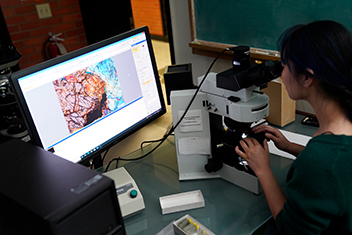A research team at South Dakota Mines led by
Gokce Ustunisik, Ph.D., assistant professor of geology and geological
engineering, has
received $278,000 in grants from the National Science Foundation to help create
a system that
can compile experimental data from around the world on the elements that make
up the earth’s crust and mantle.
Igneous rocks
and minerals are formed deep underground when magma cools and crystallizes. The
specific minerals that come from cooling magma depends on many factors such as
the makeup of the magma, the rates of cooling and how much pressure the magmas are
under.
Scientists who
study earth systems need to know the make-up and geochemistry of rocks to
better understand how natural phenomena occur. An improved understanding of those
phenomena can help geologists understand how the Earth’s crust forms and how
the forces acting on magmas drive plate tectonics. Understanding the connections between systems is
equally important and can help us constrain critical
information on the natural carbon flux out of the deep earth.
 Researchers,
like Ustunisik, use high temperature furnaces to recreate the conditions deep
underground where superheated magma of various compositions cools and hardens. In
her lab at South Dakota Mines, Ustunisik and her graduate student, Erica Cung, can
melt rocks to help determine their composition. The data from experiments like
this can give geologists an understanding to how rocks formed in a single location.
Researchers,
like Ustunisik, use high temperature furnaces to recreate the conditions deep
underground where superheated magma of various compositions cools and hardens. In
her lab at South Dakota Mines, Ustunisik and her graduate student, Erica Cung, can
melt rocks to help determine their composition. The data from experiments like
this can give geologists an understanding to how rocks formed in a single location.
But to date,
no one has been able to build a big picture with data on rock composition from multiple
experiments from around the world. Ustunisik and Cung have compiled
data from over 15,000 experiments as they develop an interface that provides
investigators access to information that was previously distributed across over
700 different publications.
“Access to
this database will both save time and taxpayer resources, and by compiling and
sharing data, scientists can quickly see what has already been done so they are
not reinventing the wheel with every experiment,” says Ustunisik.
Many
challenges remain for the team; geochemistry of any given rock can be very
complex. Additionally, the experiments on any of these rocks may have been done
differently and they have been collected from many different parts of the world.
The team must make sure they are comparing apples to apples in different data
sets from different experiments.
“One of the
challenges of big data is how to you enable the community to aid you in actually
constructing the infrastructure,” says Roger Nielsen, Ph.D., a co-principal
investigator with Ustunisik on the research.
“But without this dataset, no one can really get an idea of the big
picture,” he adds.
Enhancing the
big picture understanding of earth’s deep history, how rocks form and the
processes that govern things like plate tectonics, earthquakes and volcanoes is
a major goal of the effort. “Compiling all this data will greatly improve
computer modeling and make them more reliable,” says Ustunisik. She points out
that scientists can take this global dataset to create a common language among
researchers, do predictive modeling detailing the formation of and potential
location of valuable minerals, and in the long run give us a much more detailed
understanding of the composition of the earth itself.